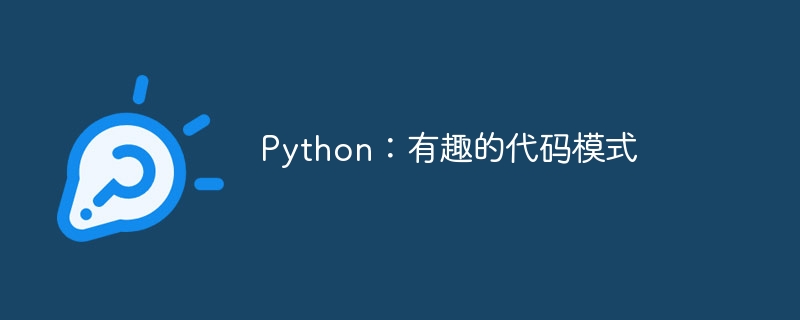Python:有趣的代码模式(有趣.模式.代码.Python...)

我主要使用 python 工作,几乎每天都会检查代码。在我们的代码库中,格式化和 linting 由 ci 作业使用 black 和 mypy 处理。所以,我们只关注改变。
在团队中工作时,您已经知道某个团队成员会编写什么样的代码。当新人加入团队时,代码审查会变得有趣。我说有趣,是因为每个人都有一些他们不自觉地使用的编码风格;无论好坏!就像我有一些,
- 设置optionaltype的值。 通常这些变量是签名的一部分
# i used (long back) to do
def func(a: int, b: optional[list] = none, c: optional[dict] = none):
if b is none:
b = []
if c is none:
c = {}
# instead i do
def func(a: int, b: optional[list] = none, c: optional[dict] = none):
b = b or []
c = c or {}
- 使用 dict 处理简单的 if..elif..else (最多 3-4 个)语句
这是一个简单的用例,您可以根据某个值返回字符串或调用函数
注意:从 3.10 开始你应该使用 match 而不是这个。而不是做,
def get_number_of_wheels(vehicle: str):
if vehicle == "car":
wheels = 2
elif vehicle == "bus":
wheels = 6
elif vehicle == "bicycle":
wheels = 2
else:
raise ...
# i prefer doing,
def get_number_of_wheels(vehicle: str):
return {
"car": 2,
"bus": 6,
"bicycle": 2
}[vehicle] # raise is now keyerror
上面是几个例子,审阅我的代码的人将会有更多的例子。
最近,一位新开发人员加入了我的团队,我注意到了一种我喜欢的模式,但我要求将其更改为简单的 if..else 情况。我会先向您展示模式,然后给出我要求更改的理由。
代码是一个装饰器,它对参数进行一些操作。让我们编写一个简单的(无用的)装饰器,它将打印调用函数/方法的参数和 kwargs 的数量。
def counter(is_cls_method: bool = false):
""" print number of args & kwargs for func/method """
def outer(f):
def inner(*args, **kwargs):
args_cnt = len(args)
kwargs_cnt = len(kwargs)
print(f"{f.__name__} called with {args_cnt=} & {kwargs_cnt=}")
return f(*args, **kwargs)
return inner
return outer
@counter()
def test1(a, b, c):
pass
class a:
@counter(is_cls_method=true)
def test1(self, a, b, c):
pass
print("function")
test1(1, 2, c=3)
test1(a=1, b=2, c=3)
print("method")
a = a()
a.test1(1, 2, 3)
a.test1(1, b=2, c=3)
运行此代码时,您应该看到
function test1 called with args_cnt=2 & kwargs_cnt=1 test1 called with args_cnt=0 & kwargs_cnt=3 method test1 called with args_cnt=4 & kwargs_cnt=0 test1 called with args_cnt=2 & kwargs_cnt=2
它工作正常,但对于方法来说,它也在计算自我。所以让我们解决这个问题!
def counter(is_cls_method: bool = false):
def outer(f):
def inner(*args, **kwargs):
args_cnt = len(args)
if is_cls_method: # check added
args_cnt -= 1 # reduced count by 1
kwargs_cnt = len(kwargs)
print(f"{f.__name__} called with {args_cnt=} & {kwargs_cnt=}")
return f(*args, **kwargs)
return inner
return outer
这是一个简单的 if 子句,但新开发人员做了其他一些有趣的布尔值使用。
我只显示更改后的代码...
args_cnt = len(args[is_cls_method:])
解决方案比使用 if 好得多,因为 python 中的 bool 只是 int。原始代码有点长,注意到这个小变化并不明显,基本 python 用户使用的代码库也是如此。而且,如果您必须猜测一条线在做什么,我认为您应该进行更改以使其显而易见。
你对此有何看法,你使用布尔值作为索引吗?
你还有类似的python模式吗?
以上就是Python:有趣的代码模式的详细内容,更多请关注知识资源分享宝库其它相关文章!
